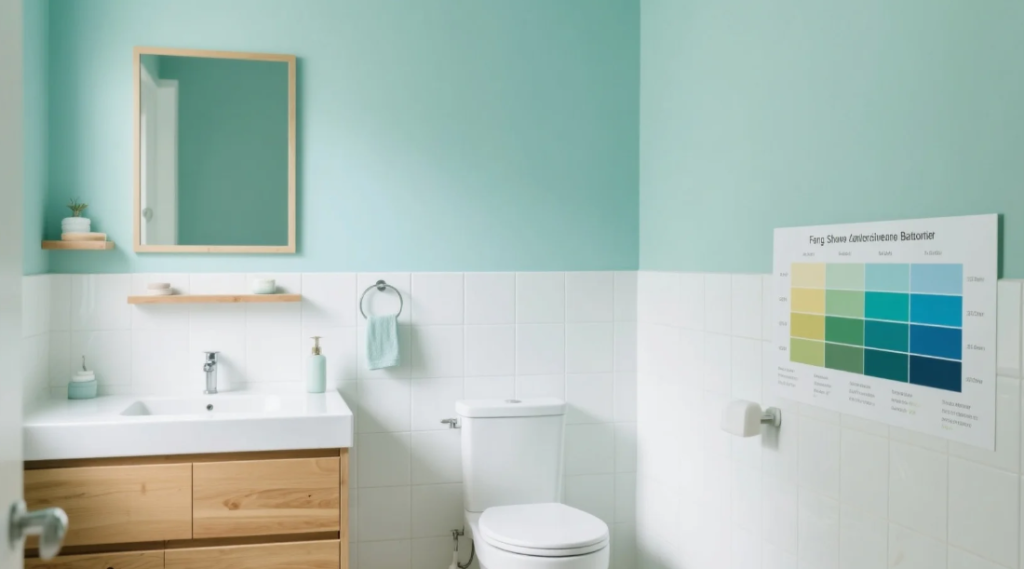Choosing the right colors for your bathroom can do more than just please the eye—it can affect the energy flow and atmosphere of your entire home. When it comes to feng shui for bathroom colors, the shades you select play a crucial role in promoting health, harmony, and positive energy. But how do you find the perfect balance between aesthetics and energy? Let’s explore this topic together.

Why Does Color Matter in Bathroom Feng Shui?
Bathrooms are unique spaces in any home. They’re where water dominates, and water energy is powerful but also potentially draining in Feng Shui terms. Because of this, the colors used in bathrooms can either balance or disrupt the flow of energy.
The right color can soothe, refresh, and even promote healing. On the other hand, the wrong choice might intensify negative energy, leading to stress or health problems.
Take Emily, for example. She once used harsh dark colors in her bathroom, and she felt constantly tired. After switching to calming light greens and soft blues, her energy improved significantly within weeks.
Therefore, selecting colors in harmony with water and the overall home energy is essential.
Which Colors Work Best in Bathrooms According to Feng Shui?
So, which colors fit well within the principles of feng shui for bathroom colors?
Light blues and seafoam greens are often recommended because they mimic the natural water element in a calming way. These hues help balance the strong water presence in bathrooms and encourage relaxation.
Soft whites and creams are another great choice. These colors reflect purity and cleanliness, enhancing clarity and fresh energy.
Earth tones like beige or light brown can ground the space, preventing the water element from feeling too overpowering. This creates a nurturing, balanced environment.
However, bright reds or intense oranges should generally be avoided. These fire-related colors may clash with water’s calming nature and can create tension.
For instance, Michael painted his bathroom a muted beige after noticing his previous bright red walls caused constant irritability. The shift helped restore peace in his daily routine.
How to Incorporate Feng Shui Colors with Bathroom Layout and Design
Choosing color isn’t just about picking a shade—it’s about where and how it’s used.
If your bathroom faces east or southeast, adding earthy tones can connect with the wood element those directions represent, supporting vitality and growth.
For bathrooms located in the north, blues and blacks can enhance water energy appropriately, bringing calm and stability.
Mirrors and lighting also play a role. Reflective surfaces paired with soft, harmonious colors amplify positive energy, while harsh lighting may disrupt it.
Jessica, whose bathroom faced north, added soft blue tiles and gentle lighting. She felt her stress levels drop and her sleep quality improve.
Yet, bathrooms in the southwest should emphasize earth tones more heavily to ground the energy and encourage relationship harmony.
Practical Tips: Using Color to Fix Common Bathroom Feng Shui Issues
Bathrooms often present challenges such as energy drainage or dampness affecting the home’s vitality.
If you struggle with energy feeling ‘washed away’ in your space, using warmer neutral colors like light browns or muted yellows can help contain that loss.
Plants are another great ally. A small green plant not only introduces wood energy but also softens water’s intensity.
However, it’s worth noting that overly dark colors combined with poor lighting can make bathrooms feel oppressive, so balance is key.
Samantha noticed her bathroom felt gloomy and used pale green paint combined with a fern. The space instantly felt lighter and more refreshing.
Case Studies: Color Changes That Transformed Bathroom Energy
Real-life examples demonstrate how mindful color choices can influence wellbeing.
David used to have stark white tiles but felt the space lacked warmth. He added beige wall panels, and soon after, family members reported feeling more relaxed during morning routines.
On the other hand, Lisa’s attempt to use deep blue without complementary colors made her bathroom feel cold and uninviting. After adding cream accents, the energy balanced out, improving her overall mood.
These stories highlight how specific colors, when thoughtfully applied, can make a big difference.
Common Myths About Feng Shui and Bathroom Colors
Some believe that only light or ‘water’ colors are suitable for bathrooms, but that’s not entirely true.
While blues and greens are helpful, ignoring earth tones or mixing elements can reduce balance.
Another misconception is that bright colors always bring positive energy. In fact, overly vibrant colors can disrupt the gentle flow in a bathroom.
Finally, some people think bathroom color changes must be dramatic to have an effect. Small shifts, like changing towels or accessories, can bring noticeable improvements too.
Final Thoughts: How to Choose Your Perfect Bathroom Color
Choosing your bathroom’s colors with feng shui for bathroom colors in mind means thinking about harmony, balance, and flow.
Start by considering your bathroom’s location, natural light, and your personal preferences. Then, blend soothing colors that enhance water without overpowering it.
Remember, balance is key. Soften dark colors with light accents and combine warm earth tones with cool blues.
Ultimately, your bathroom should feel like a place of cleansing and renewal, both physically and energetically.
FAQ
What is the best feng shui color for the bathroom?
The best feng shui color for a bathroom depends on its location and your personal energy, but generally, soft blues, seafoam greens, and neutral earth tones like beige or cream are excellent choices. These shades balance the water element naturally present in bathrooms and help promote harmony and health.
